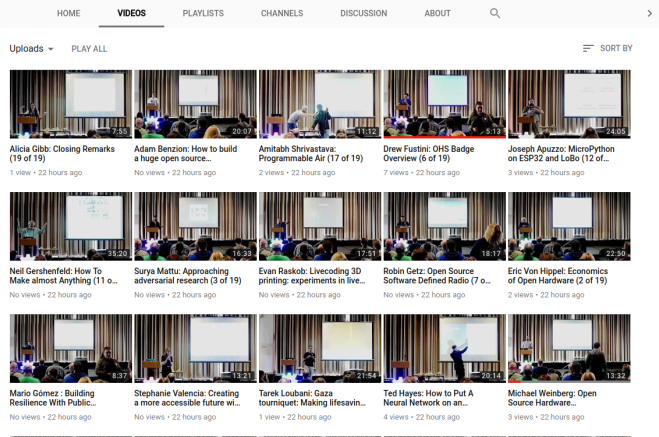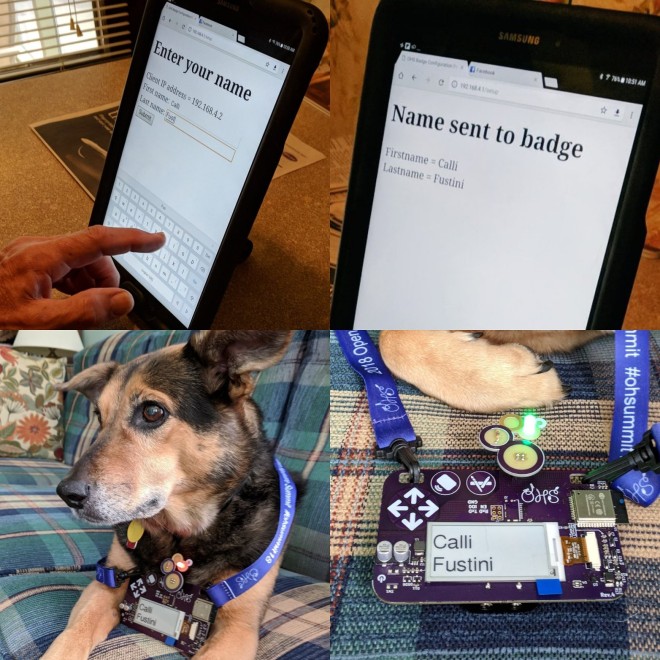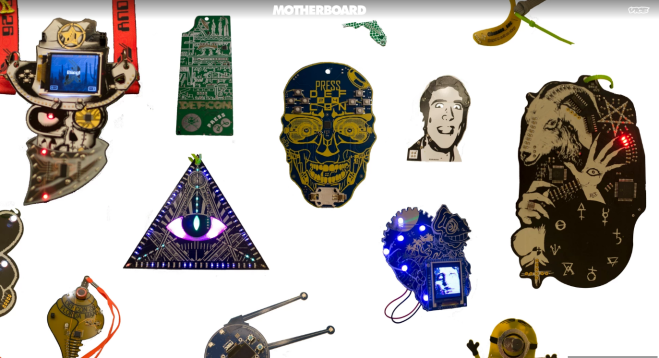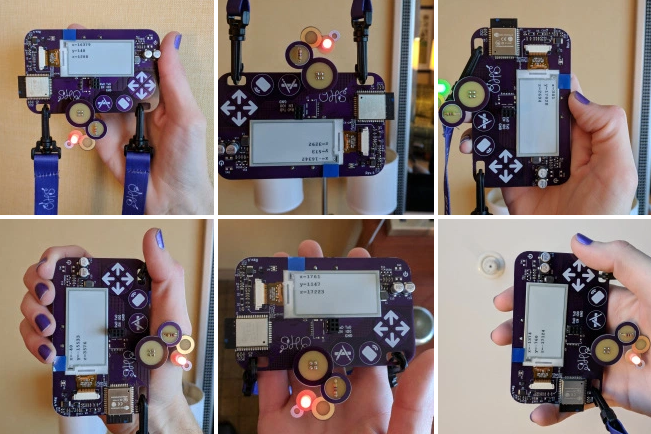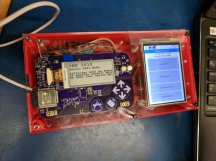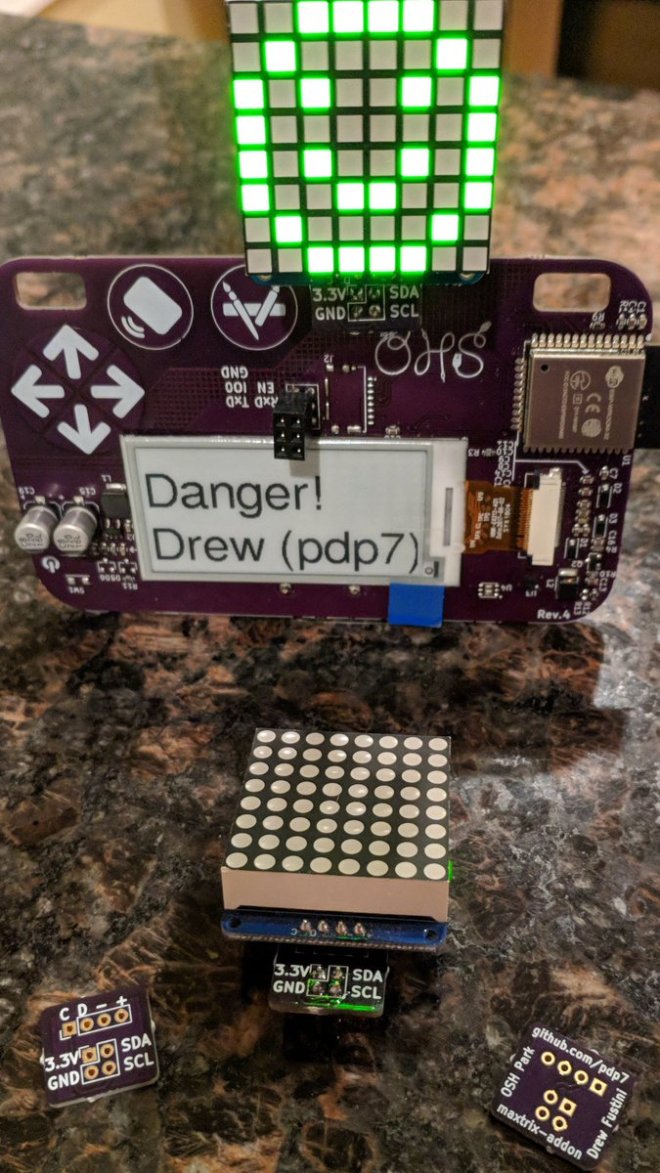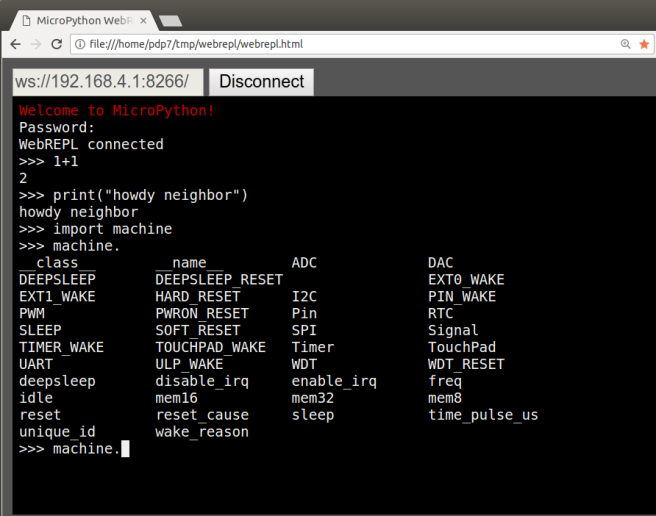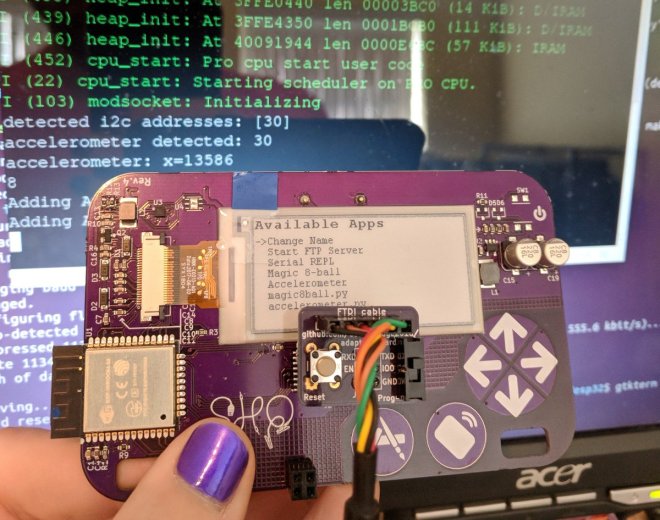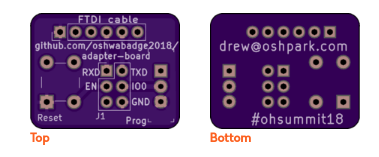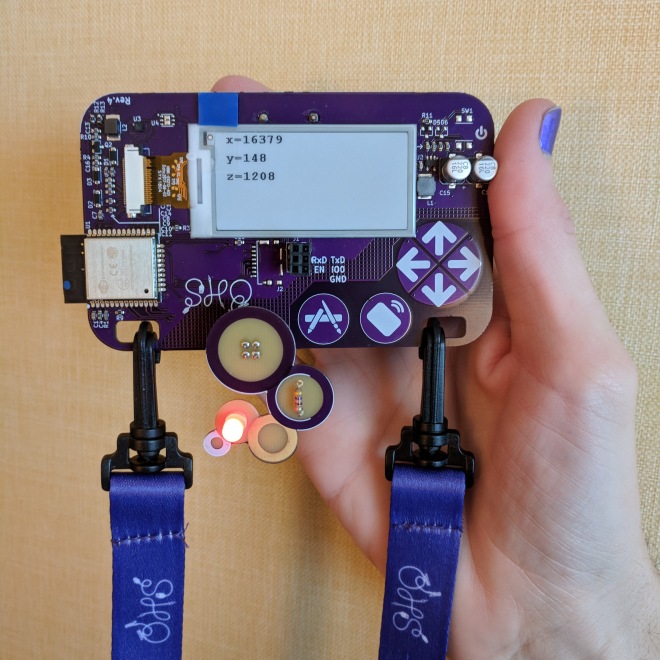The Open Hardware Summit 2018 talks are now available as individual videos on YouTube:
OHSummit18
2018 Open Hardware Summit badge
Notes from the presentation by Drew Fustini (@pdp7) on the OHS18 badge at the Alternative Computing Club meeting in Chicago
What is #BadgeLife?
Motherboard article: “A History of Badgelife, Def Con’s Unlikely Obsession with Artistic Circuit Boards”
Badgelife documentary by Hackaday
2018 Open Hardware Summit at MIT
Here is my brief overview of the badge on stage at the Summit:
Hackaday.io project for the OHS18 badge

OSH Park and Screaming Circuits produced an electronic conference badges for the 2018 Open Hardware Summit. Hardware design by Alex Camilo based on concept from ESP trINKet by Mike Rankin. Features for the OHS18 badge: ESP32 microcontroller with built-in WiFi; E-Paper to display the badge wearer’s name; badge wearer can update the displayed text from phone, tablet or laptops. Powered by 2x AA batteries.
This project was developed by a team of wonderful people that came together on Hackaday.io, in particular, this badge could not have happened without Alex Camilo and Michael Welling!
OHS18 Badge documentation website
OHS18 Badge: MicroPython documentation
OHS18 Badge: Accelerometer demo
OHS18 Badge: Magic 8-Ball MicroPython game
Python REPL using the serial port
To use the interactive Python prompt (REPL), press the menu button on the badge and select Serial REPL from the Available Apps menu. The terminal emulator connected to the serial port should then display the interactive Python prompt (REPL). You can type in MicroPython code to experiment.
MicroPython WebREPL
he 2018 Open Hardware Summit badge runs MicroPython firmware which allows for an interactive programming experience known as the REPL:
Getting a MicroPython REPL prompt
REPL stands for Read Evaluate Print Loop, and is the name given to the interactive MicroPython prompt that you can access on the ESP8266. Using the REPL is by far the easiest way to test out your code and run commands.
There is an USB-to-serial adapter board which be used to access the REPL on the badge via the serial port. However, a simpler option is to use the WebREPL:
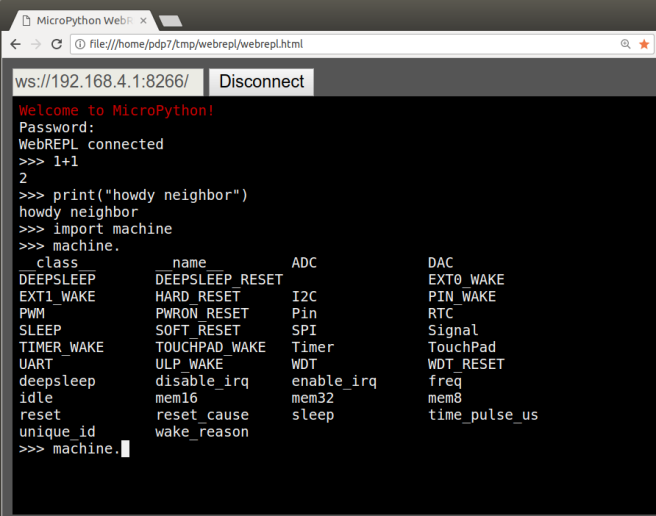
Learn to Solder add-on board
The OHS18 badge also features the DefCon 26 #badgelife add-on header. Andrew Sowa designed this OSHWA-themed Learn to Solder add-on board to connector the badge add-on header:
#badgelife add-on adapter for Adafruit LED matrix
Programming jig to flash 300 badges
Alex Camilo created this wonderful programming jig! Drew was able to use it to program all 300 badges and provision the names of the 150 people that pre-registered in time. Thanks so much to Artisan’s Asylum makerspace near Boston for giving us a space to work on the badges before the Summit!
Brian Benchoff writes on Hackaday:
The Exquisite Badges Of Open Hardware Summit
The boards were made through OSH Park, and Screaming Circuits took care of the assembly. Anyone who has ever built a badge will tell you it isn’t the assembly that gets you — it’s the programming and provisioning. This is especially true since the Open Hardware Summit badge is distributed with the attendee’s names already preloaded. That’s a few hundred badges, all with unique firmware. This is a nightmare by any definition.
However, there’s always a good solution to a problem, and [Drew] from OSH Park showed me the best programming jig I’ve ever seen during the Summit pre-game at Artisan’s Asylum.
What you’re looking at is a 3D printed box loaded up with a touch-screen display, a Raspberry Pi Zero W, and a few pogo pins. This Raspberry Pi does all the heavy lifting by connecting to the Internet, pulling down the current version of the firmware, and loading that firmware onto the badge. There are a few more options thanks to the touch-screen interface, including provisioning all the badges with the names of the attendees — this can be done by reading a list of attendees and uploading the next one to the badge in the jig. All of this is wrapped up with a nice laser-cut cover that securely holds each badge exactly where it needs to be for the pogo pins to make contact.
This is, without question, the best programming jig I’ve seen. Any badge makers out there should take note: this is how you program a few hundred badges. The badge, itself, is great and just as this post is published there will be hundreds of eager hackers futzing about with this remarkable piece of hardware. If you want to check out the current progress of the badge hacking, check out the updates on Twitter
Lesson Learned:
- Badges should have built-in USB port:
- USB connector makes it easy to multiple volunteers with laptops to flash firmware onto the badges in parallel, versus having just one programming jig
- USB connector makes it easier for people attending the Summit to experiment with modifying the firmware and developing their own functionality
- Pretend that the deadline is 1 month before the event
- We originally had the goal of being ready on September 1st for the September 27th conference, but we allowed ourselves to push the deadline for final firmware release to the day before the Summit. That meant staying up all night to flash the updated firmware on to the badges
- We should have identified the minimum feature set and simplified the functionality sooner in the design revision process
- We should have planned that we would have 3 hardware revisions and allowed for it in the schedule
Bonus Material:
Video: E-Paper under microscope!
Video: solder paste reflow!
Drew talks OHS18 badge tonight in Chicago (Nov-16)
Tonight, November 16th, at DePaul’s IRL makerspace in Chicago, Drew Fustini be speaking about the Open Hardware Summit badge and Rudy will be speaking about the Thotcon badge:
Chicago game developers and hackers! Come on out to our first meeting at the DePaul University Idea Realization Lab. We’ll have a few short presentations from local developers on the platforms and controllers they’ve developed, followed by an open show-and-tell and gathering for people to talk about current, past, and future projects.
Short Presentations for our first meeting:
Rob Lockhart – Hi-5 Heroes, featured in GDC’s alt.ctrl (https://m.youtube.com/watch?v=fwRGkLwh_sk)
Drew Fustini – Open Hardware Summit badge development (https://hackaday.io/project/112222-2018-open-hardware-summit-badge)
Rudy Ristich and Jay Margalus – Thotcon 0x8 and 0x9 games and conference badges (http://jaymargalus.com/thotcon-0x8-badges/)
#badgelife add-on adapter for Adafruit LED matrix
Adapter board to attach Adafruit 8×8 LED Matrix board as #badgelife add-on (using the DC26 SAO 2×2 pin header)
KiCad design files:
- pdp7/maxtrix-addon
- commit 07810d216f06b93ed748963ed297bc792288e67c
OSH Park shared project:
#badgelife add-on adapter for Adafruit 8×8 LED matrix
MicroPython support:
Resources:
Bring your Open Hardware Summit badge to Hackaday Supercon
Bring your Open Hardware Summit badge to Hackaday Supercon in Pasadena this weekend!
Drew Fustini will have the badge programming jig with updated firmware featuring like the MicroPython WebREPL, accelerometer demo, and Magic 8-Ball app by Steve Pomeroy
Drew Fustini will also have USB-to-serial adapter boards for badge to share!
MicroPython WebREPL on the Open Hardware Summit badge
The 2018 Open Hardware Summit badge runs MicroPython firmware which allows for an interactive programming experience known as the REPL:
Getting a MicroPython REPL prompt
REPL stands for Read Evaluate Print Loop, and is the name given to the interactive MicroPython prompt that you can access on the ESP8266. Using the REPL is by far the easiest way to test out your code and run commands.
There is an USB-to-serial adapter board which be used to access the REPL on the badge via the serial port. However, a simpler option is to use the WebREPL:
WebREPL – a prompt over WiFi
WebREPL allows you to use the Python prompt over WiFi, connecting through a browser. The latest versions of Firefox and Chrome are supported.
For your convenience, WebREPL client is hosted at http://micropython.org/webrepl . Alternatively, you can install it locally from the the GitHub repository https://github.com/micropython/webrepl
Before connecting to WebREPL, you should set a password and enable it via a normal serial connection. Initial versions of MicroPython for ESP8266 came with WebREPL automatically enabled on the boot and with the ability to set a password via WiFi on the first connection, but as WebREPL was becoming more widely known and popular, the initial setup has switched to a wired connection for improved security:
import webrepl_setupFollow the on-screen instructions and prompts. To make any changes active, you will need to reboot your device.
The MicroPython firmware for the badge has been updated to add WebREPL in the list of available apps.
You can order this USB to serial adapter board for the badge and then follow the instructions to build and flash the new firmware. The WebREPL option will turn on WiFi and put the badge into AP mode. Connect to it from your device, such as a laptop, and then connect to the badge using the WebREPL browser-based client.
Resources:
- Order the USB-to-serial adapter board for the badge
- Learn to build and flash the new badge firmware.
- Try loading Magic 8-Ball or Accelerometer apps using the FTP server feature
- Join the project on Hackaday.io if you are interested in participating in the development
OHS18 badge: accelerometer demo, adapter board, Tindie listing
Updates for the 2018 Open Hardware Summit badge project:
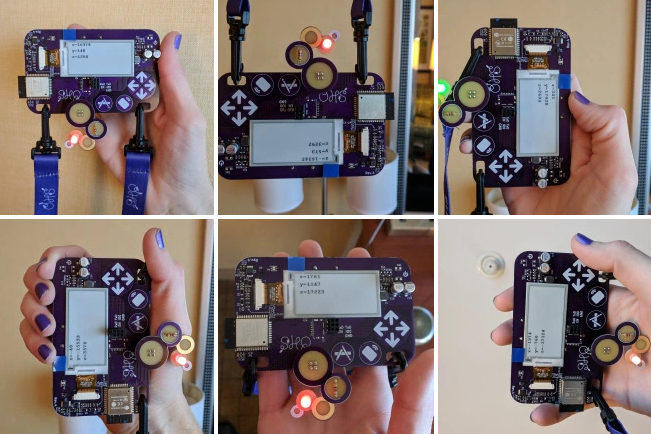
MicroPython demo app for the Accelerometer
Want to use the KX122-1037 Accelerometer (datasheet) on the 2018 Open Hardware Summit badge?
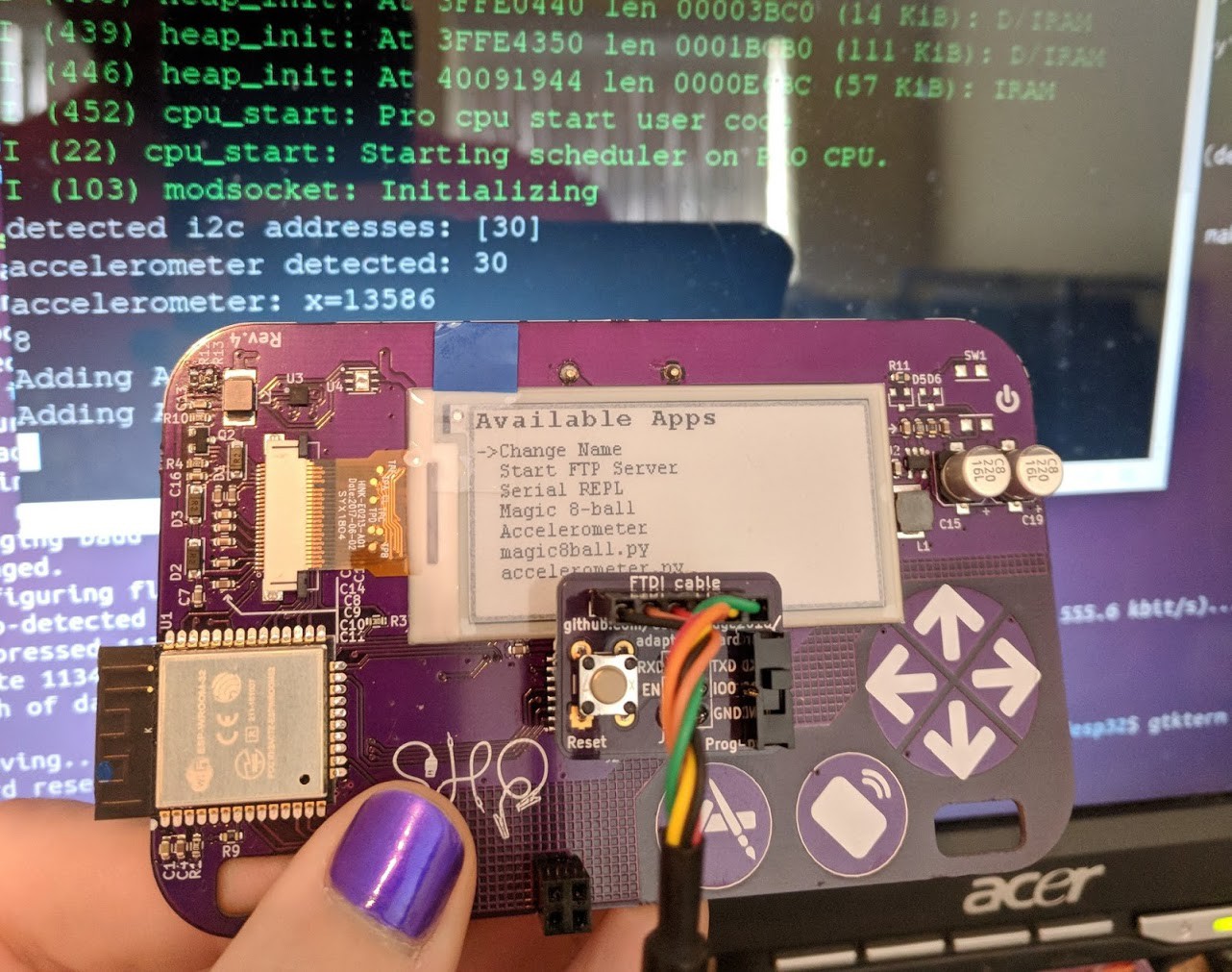
USB-to-Serial adapter board
This adapter board to connects a USB-to-serial cable to the 2018 Open Hardware Summit badge.

Extra badges being sold on Tindie
The extra badges from the Summit are being sold here on Tindie as a fundraiser for the Ada Lovelace Fellowship which provides travel assistance to the Open Hardware Summit. All sales revenue will be 100% donated to the Open Source Hardware Association (OSHWA) for this purpose.
USB-to-serial adapter board for Open Hardware Summit badge
This adapter board to connects a USB-to-serial cable to the 2018 Open Hardware Summit badge.
The badge features an ESP32 microcontroller running MicroPython firmware. The firmware provides a Python interpreter prompt (REPL) on the serial port which allows interactive programming of the badge!
A previous blog post describes how to build and flash new MicroPython firmware to the badge:
The KiCad design files are shared on GitHub:
oshwabadge2018/adapter-board
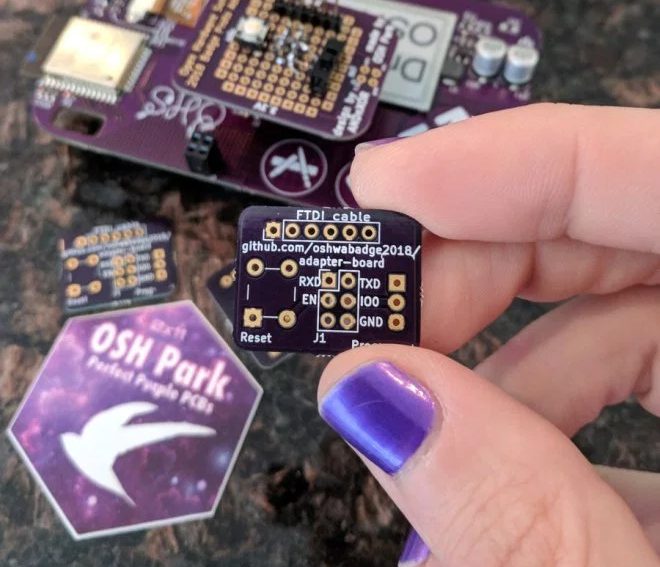 The board has been shared on OSH Park:
The board has been shared on OSH Park:
OSH Park: adapter board for USB-to-serial cable
Bill of Materials (BoM)
- Switch for programming mode
- E-Switch EG1218
- Slide Switch SPDT
- Digi-Key: EG1903-ND
- Pushbutton for reset
- Omron B3F-1000
- Tactile Switch SPST-NO
- Digi-Key: SW400-ND
- Header for FTDI usb-to-serial cable
- TE AMP 9-146282-0-06
- 1×6 Pin Header 0.1″ pitch
- Digi-Key: A34253-06-ND
- Header to connect J1 socket on badge
- Harwin M20-9720345
- 2×3 Pin Header 0.1″ pitch
- Digi-Key: 952-1921-ND
- J1 header socket on the badge
- Harwin 952-1781-ND
- 2×3 Header Socket 0.1″ pitch
- Digi-Key: M20-7830346
Digi-Key shopping cart
Resources:
- Try loading MicroPython apps using the FTP server feature:
- Learn how to build and flash new MicroPython firmware
- Join the project on Hackaday.io if you are interested in participating in the development
Open Hardware Summit badge: accelerometer demo
Want to use the KX122-1037 Accelerometer (datasheet) on the 2018 Open Hardware Summit badge?
Step 1:
Make sure that R12 and R13 are populated.
R12 and R13 are 2.2K Ohm resistors for the I2C bus. This is needed for the accelerometer to work. We mistakenly had DNP (do not place) on the BoM (Bill of Materials) for R12 and R13.
Awesome people at Artisan’s Asylum makerspace helped to solder these resistors on the badges right before Open Hardware Summit! 💜✨
It is possible that some badges were not reworked. Please email [email protected] if they are missing from your badge.
This photo shows what is will look like when R12 and R13 are missing:
Step 2:
Download the Python file named accelerometer.py from the ohs18apps repository on GitHub:
Start the FTP server and connect to the SSID listed on the badge:
Open your FTP client application and connect to 192.168.4.1:

After the transfer completes, power cycle the badge by removing the batteries and reinserting.
Press the left application button (with the paintbrush and pencil icons) to enter the menu. accelerometer.py should then be listed under Available Apps menu. Press the down cursor until accelerometer.py is selected and then press the application button again.
Step 3:
The KX122-1037 Accelerometer datasheet describes the 3 different axis:
Here are examples of the X, Y and Z axis of the accelerometer for reference:
Resources:
- Visit this gallery for more photos and screenshots
- Try Magic 8-Ball demo MicroPython app using FTP
- Try the Python REPL using this adapter board for FTDI cable
- Join this project on Hackaday.io if you are interested in participating in the developmen
Open Hardware Summit highlights by Leslie Birch
Open Source Hardware Association (OSHWA) recently held its Open Hardware Summit in Boston. For me this is one of the few times during the year that I get to hear about open source hardware projects directly from creators and users.It’salso a fine time to play with some tech on location and network with people that have the DIY bug. Public Lab was in the mix with Jeff Warren talking up his reverse engineered toaster design for OSHWA’s new certification process and Bronwen Densmore wielding the new community microscope kit.

